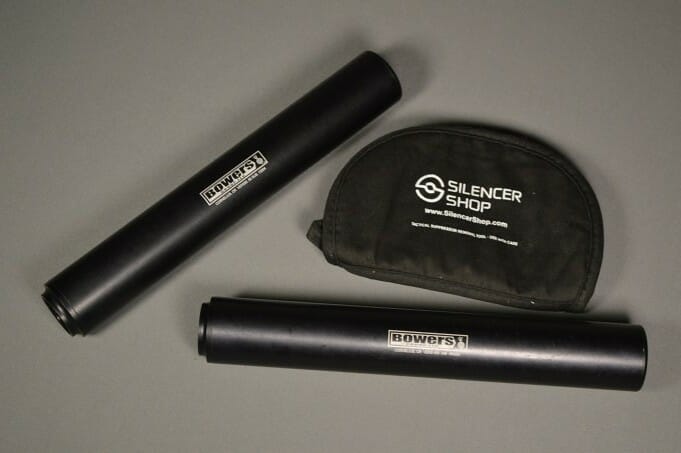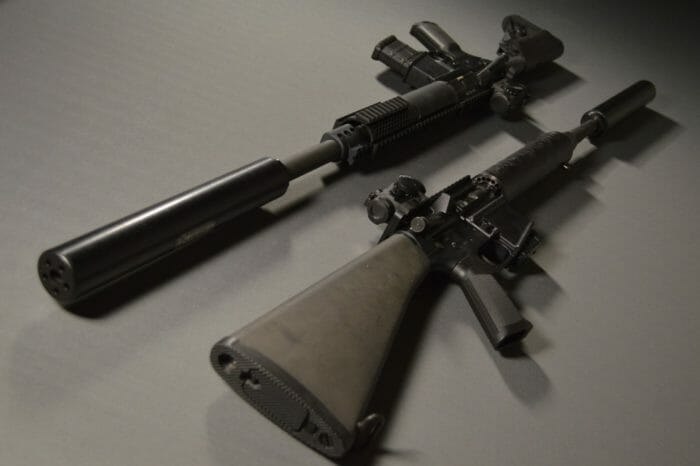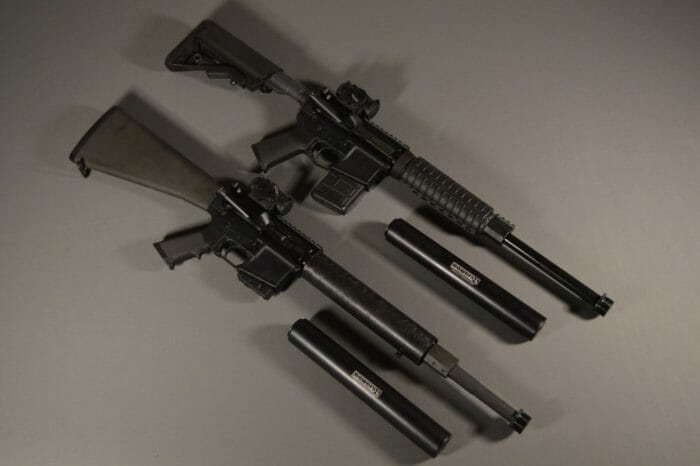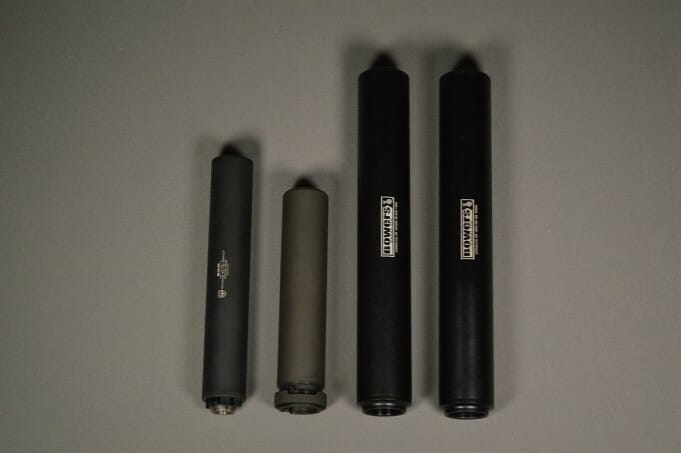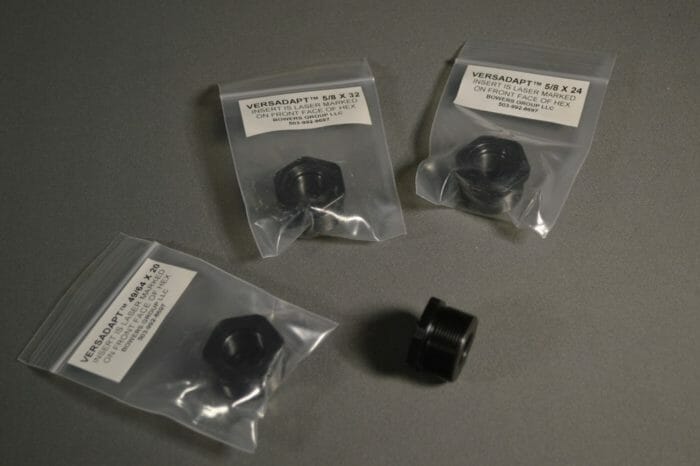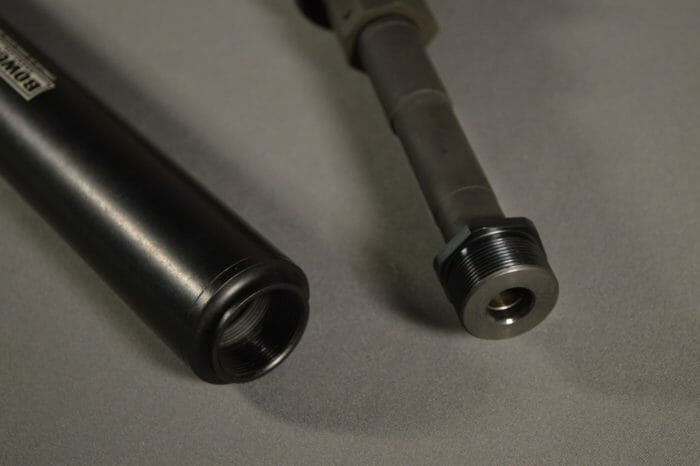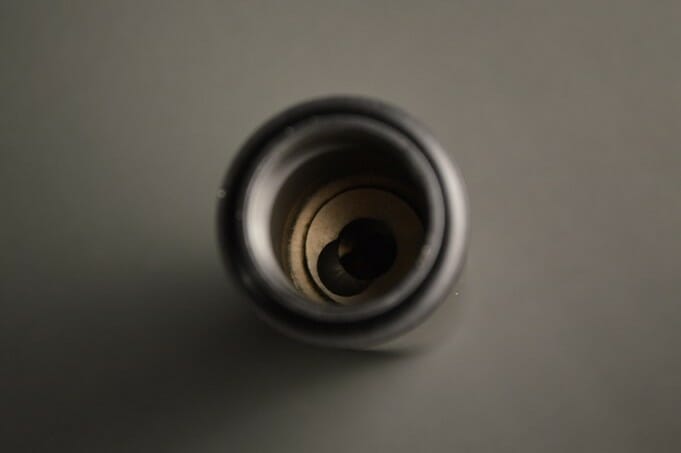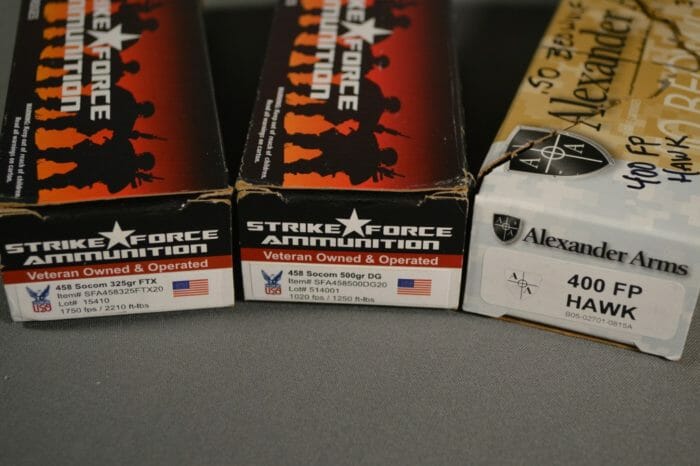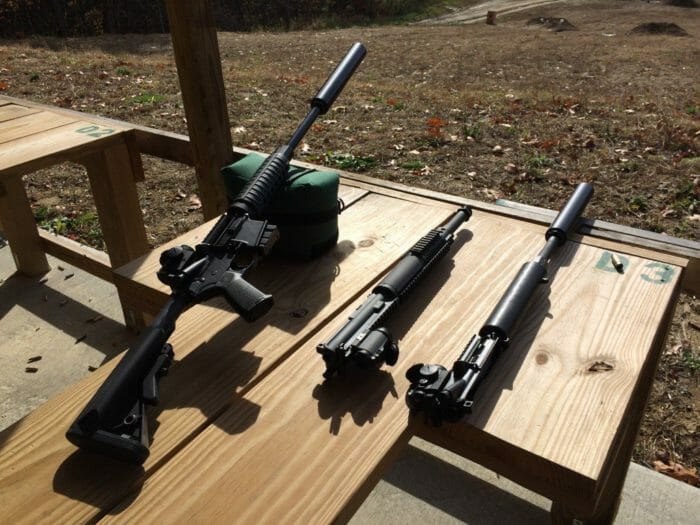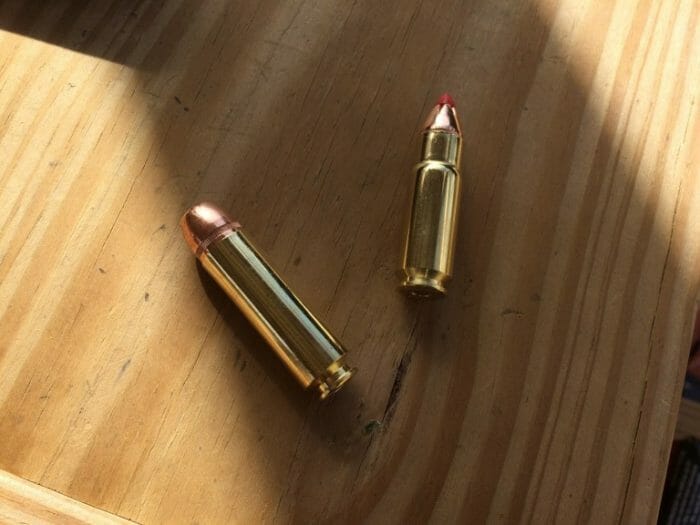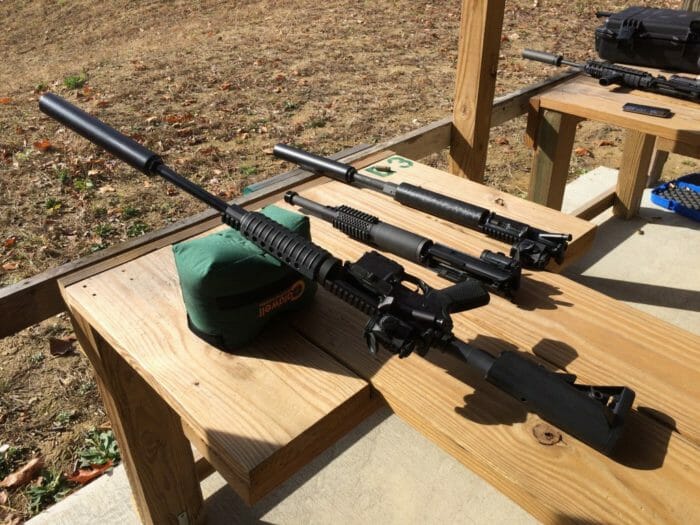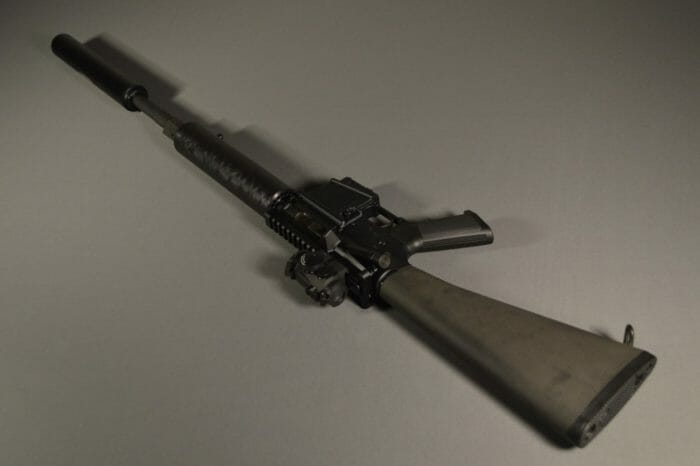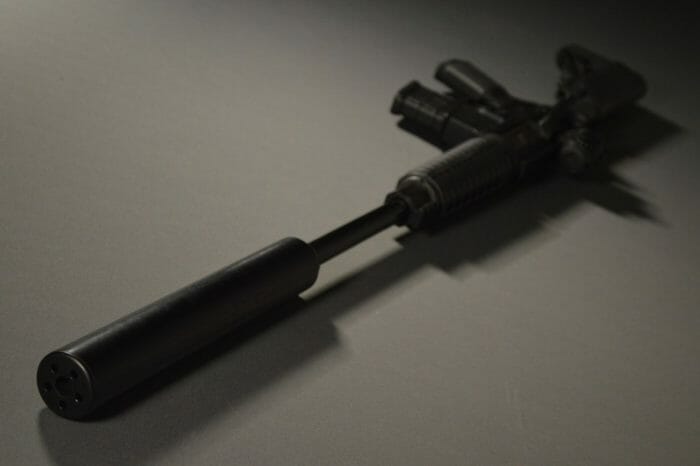Silencer Shop Authority: Bowers VERS 458 and 50 Review
Thanks to tremendous assistance from both Silencer Shop and Bowers Group, I’ve had the opportunity to spend some time with the Bowers VERS 458 and VERS 50 suppressors over the last two weeks. Even though the 458 and 50 have different bore sizes, they are essentially the same design. As such, we will look at them jointly. So do these cans effectively tame big boomer calibers? Read on to find out.
Size and Weight
Opening the box, I immediately noticed that the VERS suppressors are larger than most rifle silencers. With the Versadapt insert, the cans measure 11 3/8 inches in length, on top of their large 1 3/4 inch diameter. If you’re used to smaller caliber rifle suppressors, the VERS 458 and 50 will seem large, but this sort of volume is necessary to adequately suppress big-bore rounds.
According to my postal scale, both silencers weigh around 20 ounces with Versadapt mounts installed. When you consider the size of the silencers, the weight is quite reasonable; there are 30 caliber silencers that are heavier. Both of my examples from Silencer Shop feature fully stainless steel baffles, but Bowers also offers a less expensive version of the VERS 50 with just a stainless blast baffle and the rest aluminum if you want something lighter. On all models, the tube is lightweight aluminum.
Mounts
The VERS name comes from the threaded Versadapt inserts that the suppressors use to mount to a myriad of standard and oddball thread pitches. The system is not as sexy as some of the quick attach mounts out there, but it works well. The Versadapt inserts feature wrench flats, which make tightening the adapter to a rifle’s barrel or the VERS suppressor very easy. Once tightened down, I had absolutely no problems with loosening during use.
Design and Materials
As I previously mentioned, the VERS 458 and 50 both use anodized aluminum tubes. The relatively low muzzle pressures of big-bore AR rounds, combined with the large internal volume of the VERS suppressors, make aluminum workable for this application. Considering the impressive overall size of the silencers, aluminum is undoubtedly welcome from a weight standpoint.
In both of my demo cans, the baffle stacks were entirely manufactured of stainless steel. Bowers’ standard VERS 50 features a stainless blast baffle and subsequent aluminum baffles. Upgrading to the full stainless core costs an additional $150, but increases the suppressor’s maximum rating from projectiles moving 2,200 feet per second to those ticking along at 2,700 fps. If shooters plan to use some of the hottest big-bore rounds, the upgrade might make sense. Readers should note that the VERS 458 is offered with a stainless core only.
For suppressors that perform really well (more on this later), the VERS 458 and 50 both feature the same, surprisingly simple baffle stack. In essence, the core is composed of five stepped baffles with mouse holes or ports cut into both the front and backside. The ports help to create lateral gas movement inside the can and are known to be very effective in maximizing performance, but on the whole, the baffles are pretty simple. Maybe it really is true that less is sometimes more. Keeping the baffle count and complexity low allows for more internal volume, and when it comes to suppression, volume is king.
Range Report
With the VERS 458 and 50, I tested a variety of rounds from Alexander Arms and Strike Force Ammunition. In .50 Beowulf, I had the chance to try Alexander Arms’ 400-grain JFP Hawk load and their 350-grain ammo based on the Speer JHP bullet. Both of the Beowulf varieties were supersonic, and at the moment, no official subsonic loading exists for the cartridge (though some people have developed their own subsonic loads). In .458 SOCOM, Bowers hooked me up with 500-grain soft point subsonic and 325-grain loads built around Hornady’s FTX bullet. Both types of .458 SOCOM came from Strike Force Ammunition, a small Indiana company that operates near my old hometown. Since the shooting experience with each type of ammunition varied pretty drastically, I’ll spend a few minutes talking about each.
The first rounds I tested with the VERS 50 were the 400 grain Hawk loads. These are the most powerful official .50 Beowulf cartridges, ticking along at 1,800 FPS and carrying around 2,900 ft-lbf (3,900 J) of energy. That’s almost 10% more power than hot .308 or 7.62x54mmR! Without a suppressor and out of a relatively light AR-15, this load’s recoil was impressively stout. However, the VERS 50 did more to tame Alexander Arms’ beast than I could ever have expected. While the can reduced the report to levels that were still a little louder than suppressed .308, the VERS sliced at least 1/3 of the recoil off the round. If you’re shooting salty loads like the Hawk, the VERS will shine primarily in its ability to effectively mitigate recoil.
My experience with the 350-grain JHP pills was essentially the same as my time with the Hawk. As heavy as these rounds are, a 50-grain difference is relatively insignificant when it comes to felt recoil or muzzle report. As a result, these may have been marginally more pleasant to shoot, both suppressed and unsuppressed. The VERS was equally impressive in dampening the rifle’s report and, and even more so, its recoil.
The story with the .458 SOCOM loads and the VERS 458 was a bit different. With the 325 grain Strike Force ammunition, I found the rifle to be a very pleasant shooter, even without the suppressor. Part of this could be the heavier upper assembly that I used to test this load, but it could also be that the round itself carries a bit less energy than the .50 Beowulf I sampled. Regardless, the 325-grain rounds were noticeably quieter and carried substantially less recoil than the .50s when used with the VERS 458. These sounded quite a lot like suppressed .308, and I had no problem blasting through my limited supply of Strike Force’s 325 grain round.
If you’re wondering why I’ve waited until now to talk about Strike Force’s 500-grain subsonic load, it is because I wanted to save the best for last. I am in no way exaggerating when I say that shooting this round through the VERS 458 was awesome. Unsuppressed, the 500 grain round was far more pleasant than its peers, especially in terms of felt recoil. It also happens to be carrying around half as much energy, for those keeping score. With the VERS 458, the subsonic ammunition sounded better than a suppressed 5.56mm AR-15 and just a little louder than a suppressed .45 ACP handgun. Considering the amount of powder used to push such a heavy bullet, it is remarkable that the VERS performs so well. Shooters who plan to spend the whole day in the field on a hog hunt would be wise to consider this combination.
With suppressors as large as the VERS 458 and 50, first round pop (FRP) is always going to be a concern. Unfortunately, some FRP is present with both cans, but it is not as prevalent as I expected. Silencer Shop’s testing of the VERS 458 with supersonic loads found that the first shot was around 5 dB louder than subsequent rounds (139 dB versus 134 dB). In my opinion, the FRP is much less noticeable than the numbers might indicate. It also seems to vary based on the ammunition used and hearing protection (which should still be used when shooting suppressed) tends to level out the rifle’s perceived report anyway.
Thanks to the large volume internal volume of the VERS suppressors, gas blowback is negligible. Unlike shooting suppressed 5.56mm ammunition, using the VERS on a .458 or .50 caliber AR-15 was a very pleasant experience (save the added recoil). In addition to the VERS’s large volume, I think the sizeable bore aperture and lower muzzle pressure of the big bore ammunition combine to negate some backpressure.
Due to ammunition limitations, I only tested point of impact (POI) shift with the VERS 458 and Strike Force’s 325 grain load. While zeroing the mounted Aimpoint at between 25 and 30 yards, I found the POI with the VERS to consistently be one inch up and right from the unsuppressed group. This translates to between three and four MOA of shift. Given the fact that my POI varied so drastically with different loadings, I would hesitate to take my shift measurements as gospel, but it should give potential buyers a general idea of the VERS’s potential side effects.
Conclusion
Beyond suppression, one of the things that impressed me the most when using the VERS 458 and 50 suppressors was the way the silencers effectively mitigated felt recoil. While the two offer solid suppression (especially the VERS 458 paired with Strike Force’s 500-grain subsonic), the icing on the cake is that they also happen to be two of the best muzzle brakes I have ever used. Overall, both silencers take rounds that are generally quite harsh to shoot and make them orders of magnitude more enjoyable. If you are a hunter looking to suppress big bore ammunition, Bowers’ options are excellent choices.
As of writing, the VERS 458 and 50 can both be had from Silencer Shop for less than $900. At this price, they are among the most affordable large bore suppressors, and there aren’t many available for such large calibers. With these factors in mind, Bowers certainly has my seal of approval.
An information security professional by day and gun blogger by night, Nathan started his firearms journey at 16 years old as a collector of C&R rifles. These days, you’re likely to find him shooting something a bit more modern – and usually equipped with a suppressor – but his passion for firearms with military heritage has never waned. Over the last five years, Nathan has written about a variety of firearms topics, including Second Amendment politics and gun and gear reviews. When he isn’t shooting or writing, Nathan nerds out over computers, 3D printing, and Star Wars.

